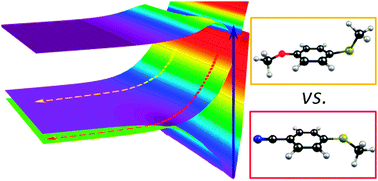Tuning photochemistry: substituent effects on πσ* state mediated bond fission in thioanisoles†
Abstract
We report a combination of experimental (velocity map imaging measurements of the methyl (Me) radical products) and ab initio electronic structure studies that explore the influence of substituents (Y) on the dynamics of S–Me bond fission following excitation to the first excited S1 states of thioanisole and three 4-substituted thioanisoles (4-YPhSMe, with Y = H, Me, MeO and CN). In all bar the case that Y = CN, the resulting 4-YPhS products are found to be formed predominantly in their excited (Ã) electronic state. In all cases, the relative yield of ![[X with combining tilde]](https://www.rsc.org/images/entities/i_char_0058_0303.gif) state products increases upon tuning to shorter excitation wavelengths and, in the specific case of bare thioanisole (as found previously by Lim and Kim, Nat. Chem., 2010, 2, 627), jumps when exciting on the parent resonance assigned to the S1(v7a = 1) level. Two conical intersections (CIs) in the RS–Me stretch coordinate are crucial to rationalising all of the observed dynamics. The first, (CI-1, between the diabatic 1ππ* and dissociative 1πσ* potential energy surfaces (PESs) at RS–Me ∼ 2 Å) lies above the S1(v = 0) level in energy, and the calculated minimum energy path through this barrier involves substantial deviations from planarity in all bar 4-CNPhSMe. Beyond this barrier, the potential is quite steeply repulsive, and Me + 4-YPhS(Ã) products are the inevitable products if the molecular framework is unable to re-planarise within the time it takes for the dissociating molecules to pass through the region of CI-2 (between the diabatic 1πσ* and ground (S0) states) where the product electronic branching is determined. The gradual increase in the yield of 4-YPhS(
state products increases upon tuning to shorter excitation wavelengths and, in the specific case of bare thioanisole (as found previously by Lim and Kim, Nat. Chem., 2010, 2, 627), jumps when exciting on the parent resonance assigned to the S1(v7a = 1) level. Two conical intersections (CIs) in the RS–Me stretch coordinate are crucial to rationalising all of the observed dynamics. The first, (CI-1, between the diabatic 1ππ* and dissociative 1πσ* potential energy surfaces (PESs) at RS–Me ∼ 2 Å) lies above the S1(v = 0) level in energy, and the calculated minimum energy path through this barrier involves substantial deviations from planarity in all bar 4-CNPhSMe. Beyond this barrier, the potential is quite steeply repulsive, and Me + 4-YPhS(Ã) products are the inevitable products if the molecular framework is unable to re-planarise within the time it takes for the dissociating molecules to pass through the region of CI-2 (between the diabatic 1πσ* and ground (S0) states) where the product electronic branching is determined. The gradual increase in the yield of 4-YPhS(![[X with combining tilde]](https://www.rsc.org/images/entities/i_char_0058_0303.gif) ) radicals upon tuning to shorter photolysis wavelengths, the much increased branching into PhS(
) radicals upon tuning to shorter photolysis wavelengths, the much increased branching into PhS(![[X with combining tilde]](https://www.rsc.org/images/entities/i_char_0058_0303.gif) ) products when exciting the PhSMe (S1, v7a = 1) level and the dominance of 4-CNPhS(
) products when exciting the PhSMe (S1, v7a = 1) level and the dominance of 4-CNPhS(![[X with combining tilde]](https://www.rsc.org/images/entities/i_char_0058_0303.gif) ) products in the specific case that Y = CN can all be understood in terms of a (relative) lowering of the effective barrier associated with CI-1, thereby allowing access to the dissociative region of the PES at closer-to-planar geometries.
) products in the specific case that Y = CN can all be understood in terms of a (relative) lowering of the effective barrier associated with CI-1, thereby allowing access to the dissociative region of the PES at closer-to-planar geometries.


 Please wait while we load your content...
Please wait while we load your content...